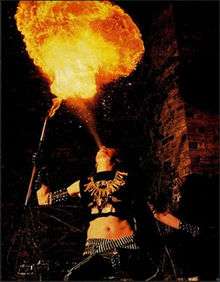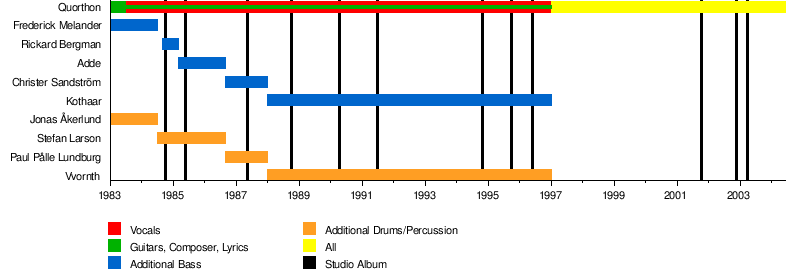Bathory (band)
Bathory was a Swedish extreme metal musical group which was founded in Vällingby, Sweden, in 1983. The outfit selected their name after Hungarian countess Elizabeth Báthory and are considered to be one of the most influential acts in heavy metal, especially black metal. Lords of Chaos described Bathory's first four albums as "the blueprint for Scandinavian black metal".[4][5]
Bathory | |
|---|---|
 | |
| Background information | |
| Origin | Vällingby, Sweden |
| Genres | |
| Years active | 1983–2004 |
| Labels |
|
| Past members |
|
Bathory, however abandoned the black metal sound for their fifth record Hammerheart (1990), which is often cited as the first Viking metal album.[6] Bathory continued in the Viking metal style throughout the 1990s and early 2000s, although the band experimented with a pure thrash metal style on the albums Requiem (1994) and Octagon (1995). Bathory ended when frontman, founder and main songwriter Tomas "Quorthon" Forserg died from heart failure in 2004, he was 38 years old.
History
Early years (1980s)
Bathory formed in Vällingby in March 1983.[7] Quorthon (then known as Ace, after Ace Frehley of Kiss), a 17-year-old guitarist, was joined by bass guitarist Frederick Melander and drummer Jonas Åkerlund. According to Quorthon, he settled on the name 'Bathory' after a visit to the London Dungeon, although Jonas says that it was taken from the Venom song "Countess Bathory".[8] Before settling on 'Bathory', the band considered several names; including Nosferatu, Natas, Mephisto, Elizabeth Bathory and Countess Bathory.[9] Quorthon worked part-time at the small record label Tyfon Grammofon, which was owned by his father, Börje Forsberg.[8] In late 1983, the label was putting together a compilation of songs by Scandinavian metal bands.[10] However, at the last minute, one of the bands backed out. Tyfon agreed to let Bathory appear on the record as a replacement. The album, called Scandinavian Metal Attack, was released in March 1984 and was Bathory's first appearance on record.[11] Unexpectedly, the two Bathory tracks "Sacrifice" and "The Return of Darkness and Evil" drew a great deal of fan mail.[12]
Soon afterward, Tyfon asked Quorthon to record a full-length album.[11] His bandmates having moved away, Quorthon recruited Rickard Bergman from his former oi-punk band Stridskuk as bassist and Stefan Larsson from punk band Obsklass as drummer.[13] On 22 May 1984, they had their first and only rehearsal together before recording the album.[11] Two songs were recorded at the May 22 rehearsal: "Witchcraft" and "Satan My Master" making it the first recording of the debut album line-up.[13] The debut album, Bathory, was recorded in June at Heavenshore Studio (a converted garage) in Stockholm[11] and released in October that year. Over the next four years, Bathory released a further three albums: The Return…… (1985), Under the Sign of the Black Mark (1987) and Blood Fire Death (1988).
Bathory's early work was dark, fast, heavily distorted and raw recording (lo-fi). Quorthon's vocals were harsh, high-pitched and raspy with occasional shrieks and screams. The band's lyrics focused on 'dark' topics and included anti-Christian and 'Satanic' references.[14] These traits came to define black metal[9] and the band used this style on their first four albums. Quorthon said that the band were not Satanists but used 'Satanic' references to provoke and attack Christianity. With the third and fourth albums he began "attacking Christianity from a different angle", realizing that Satanism is a "Christian product" and seeing them both as "religious hocus-pocus".[14] The term 'black metal' came from Venom's 1982 album of that name. Many fans and reviewers have claimed Venom was an influence on Bathory,[15] or even accused Bathory of copying Venom;[16][7] however, Quorthon said that the band's early work was influenced primarily by Black Sabbath, Motörhead and GBH, and that he "heard Venom for the first time in late 1984 or early 1985" and never owned a Venom album.[7] Another band Quorthon cited as an early inspiration was British oi!/street punk band the Exploited.[17] Bathory's early sound has always been associated with Slayer but Quorthon denied being influenced by them.[18]
Bathory stopped performing live in 1985, with Quorthon viewing organizing concerts as too much hassle.[9]
Although Bathory's fourth album, Blood Fire Death (1988), largely followed in the style of the albums before it, some songs had a very different style. These songs have a much slower tempo, acoustic passages, choral background singing, and lyrics about Vikings and Norse mythology. Music critic Eduardo Rivadavia of AllMusic describes this 'epic' style as "possibly the first true example" of Viking metal.[19]
Viking metal years (1990s–2000s)
After Blood Fire Death, the band shed its early black metal style. Their fifth album, Hammerheart (1990), was the first "archetypical Viking metal album".[20] This was said to have been influenced by the American power metal band Manowar, although Quorthon described this rumour as "another total misconception".[18] A music video was made for the song "One Rode to Asa Bay". The style of Hammerheart was continued on Twilight of the Gods (1991) and Blood on Ice (recorded in 1989 but completed in 1996).
With Requiem (1994) and Octagon (1995), Bathory changed style once more, this time turning to retro-thrash in the vein of 1980s Bay Area thrash bands. However, the 2001 release Destroyer of Worlds was a transitional release that led to a full return to the Viking metal style with the releases of Nordland I (2002) and Nordland II (2003).
Quorthon's death
In June 2004, Quorthon was found dead in his home, apparently due to heart failure.[9] He was known to suffer from heart problems in the past. On 3 June 2006, Black Mark Production released a box set in tribute to Quorthon, containing three CDs of his favorite Bathory and Quorthon songs, a 176-page booklet, a DVD with his long-form video for "One Rode to Asa Bay", an interview and some rare promo footage and a poster.
Several Bathory tribute albums have been compiled by black metal artists, such as In Conspiracy with Satan – A Tribute to Bathory and Voices from Valhalla – A Tribute to Bathory. In August 2004, several members of the Norwegian black metal scene gathered to perform Bathory songs in a set titled A Tribute to Quorthon at the Hole in the Sky Festival in Bergen, Norway. These musicians included Abbath (Immortal), Apollyon (Aura Noir), Faust and Samoth (Emperor and Zyklon), Gaahl (Gorgoroth), Grutle Kjellson and Ivar Bjørnson (Enslaved), Nocturno Culto (Darkthrone) and Satyr (Satyricon).[21]
In popular culture
The Swedish black metal band Watain played a live tribute to Quorthon and the band Bathory at the Sweden Rock Festival 2010. The resulting recording was the limited-edition album Tonight We Raise Our Cups and Toast in Angels Blood: A Tribute to Bathory with 7 tracks, and was released on February 23, 2015. It was also released as 12" album, the latter in 1300 numbered copies with four tracks, "A Fine Day to Die" (10:48), "The Return of Darkness and Evil" (4:36), "Rite of Darkness" (2:19) and "Reaper" (2:46) on Side A and three tracks "Enter the Eternal Fire" (7:14), "Sacrifice" (4:06) and "Born for Burning" (7:11) on Side B.
The release proved very popular with Swedish public, with the limited vinyl edition reaching number 1 on the vinyl chart. The album made it also to number 2 on the national Sverigetopplistan chart, the official Swedish Albums Chart in February 2015.[22]
Band members
- Final lineup
- Quorthon (Thomas Börje Forsberg) – vocals, guitar, bass guitar, drums, lyrics, composer (1983–2004; died 2004)
- Previous members
- Freddan/Hanoi (Frederick Melander) – bass guitar (1983–1984)
- Vans McBurger (Jonas Åkerlund) – drums (1983–1984)
- Ribban – bass guitar (1984)
- Stefan Larsson – drums (1984–1986)
- Adde – bass guitar (1985)
- Christer Sandström – bass guitar (1986–1987)
- Paul Pålle Lundburg – drums (1986–1987)
- Kothaar – bass guitar (1988–1996)[lower-alpha 1]
- Vvornth – drums (1988–1996)[lower-alpha 1]
- Timeline

Discography
Studio albums
- Bathory (1984)
- The Return…… (1985)
- Under the Sign of the Black Mark (1987)
- Blood Fire Death (1988)
- Hammerheart (1990)
- Twilight of the Gods (1991)
- Requiem (1994)
- Octagon (1995)
- Blood on Ice (1996)
- Destroyer of Worlds (2001)
- Nordland I (2002)
- Nordland II (2003)
Compilation albums
- Jubileum Volume I (1992)
- Jubileum Volume II (1993)
- Jubileum Volume III (1998)
- Katalog (2001)
- In Memory of Quorthon (2006)
Notes
- Names "Kothaar" and "Vvornth" were adopted by the different people who were playing bass guitar and drums for the Bathory at the time. No official member names were released during the period.
References
- "Bathory – Under the sin". Bathory.nu. Retrieved 29 July 2014.
- "Bathory – Under the sin". Bathory.nu. Retrieved 29 July 2014.
- "Essential Black Metal Listening: BATHORY Under the Sign of the Black Mark". Metalinjection.net. 27 February 2013. Retrieved 1 October 2018.
- Moynihan, Michael; Søderlind, Didrik (2003) [1998]. Lords of Chaos: The Bloody Rise of the Satanic Metal Underground (revised and expanded ed.). Venice: Feral House. p. 21.
- Nelson, Dan (2008). All Known Metal Bands. McSweeney's. ISBN 978-1-932416-92-3.
Bathory
- Maisano, Anthony. "Today in Metal: 'Hammerheart' by Bathory turns 24 years old". Metal Insider. Retrieved 20 May 2016.
- Luxi Lahtinen: BATHORY – An Epic Interview with Quorthon, accessed on 28 December 2012.
- Johannesson & Klingberg 2011, pp. 52–62.
- Santos, José Carlos (2009). Terrorizer's Secret History of Black Metal. Dark Arts Ltd. pp. 10–11.
- Ekeroth 2008, p. 29.
- Ekeroth 2008, p. 30.
- McManus, Peter (1987). "Stranger than Strange – Quorthon Uncloacks His Secrets in an Exclusive Interview..." Power Metal. Retrieved 8 September 2012.
- "Bathory - Bathory". www.bathory.nu. Retrieved 2 October 2019.
- "Writing the deeds of Darkness and Evil". Official Bathory website. Retrieved 29 October 2012.
- Moynihan, Michael; Søderlind, Didrik (1998). Lords of Chaos: The Bloody Rise of the Satanic Metal Underground (first ed.). Venice: Feral House. pp. 16–18.
- Götz Kühnemund: »Heavy Metal ist was für Weicheier!«. Die erste Generation des Black Metal. In: Rock Hard, no. 269, October 2009, p. 72.
- Swedish Death Metal: "If I hadn't started to play in punk bands around '79–80 I could have ended up on the streets, with a needle in my arm. Luckily, I didn't have any such friends, so I got involved with the punk movement, and was inspired by bands like Exploited and GBH."
- "Quorthorn (Bathory) Interview at anus.com – Death/Black Metal Interviews Section". anus.com. Archived from the original on 28 July 2012. Retrieved 8 September 2012.
- Rivadavia, Eduardo. "Blood Fire Death – Bathory : Songs, Reviews, Credits, Awards : AllMusic". AllMusic. Retrieved 16 February 2013.
- Rivadavia, Eduardo. "Hammerheart – Bathory : Songs, Reviews, Credits, Awards : AllMusic". AllMusic. Retrieved 8 September 2012.
- "Norway's Black Metal Elite To Pay Tribute To Quorthon". www.metalunderground.com. Retrieved 17 March 2019.
- "WATAIN Hit National Chart In Sweden With Tonight We Raise Our Cups And Toast In Angels Blood Limited LP". Bravewords.com. Retrieved 1 October 2018.
Bibliography
- Ekeroth, Daniel (2008). Swedish Death Metal. Bazillion Points Books. ISBN 978-0-9796163-1-0.CS1 maint: ref=harv (link)
- Johannesson, Ika; Klingberg, Jon Jefferson (2011). Blod Eld Död – En svensk metalhistoria. Alfabeta Bokförlag AB. ISBN 978-9-1501133-4-1.CS1 maint: ref=harv (link)
External links
- Bathory on Black Mark Production
- Bathory at AllMusic
- Bathory discography at Discogs
- Bathory discography at MusicBrainz